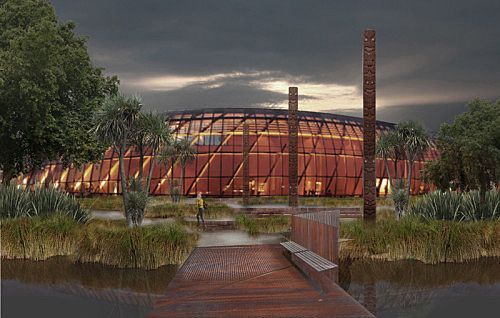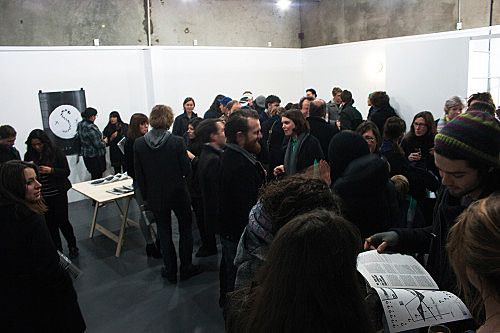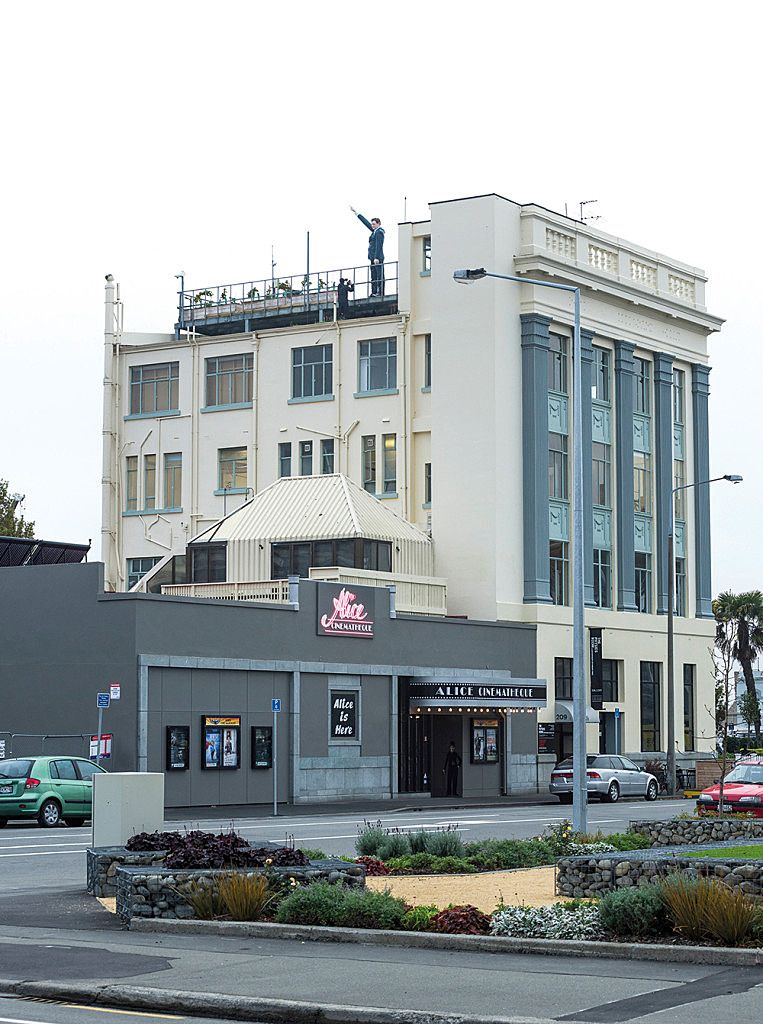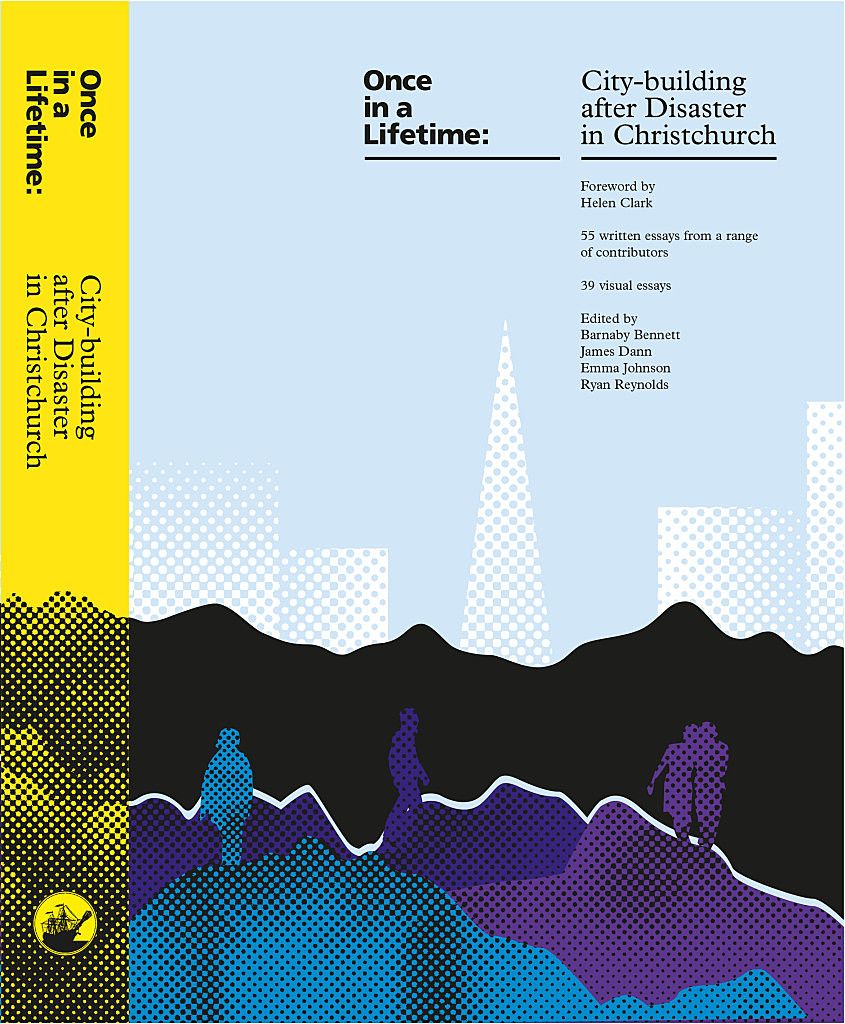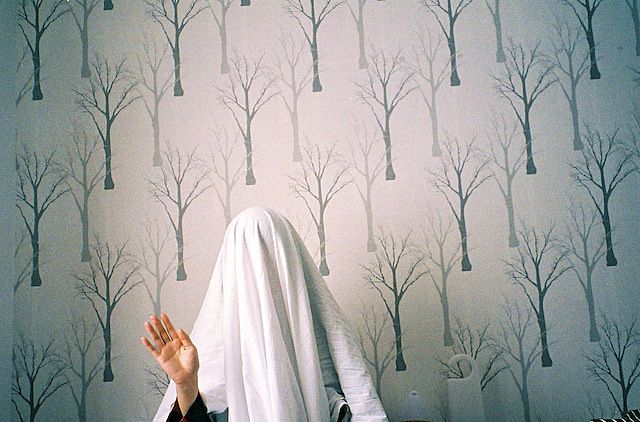Developing the Arts Ecology of Christchurch
In rebuilding the city's arts infrastructure, The Christchurch Central Recovery Plan (CCRP) fails to acknowledge the artists and initiatives who have played a critical role in the arts since the earthquakes - and in doing so, regresses the city to a more traditional model, writes Melanie Oliver.
According to the Christchurch Central Recovery Plan (CCRP) ‘fostering the arts and creative industries is crucial to building a 21st century international city’. Cultural revitalisation is highlighted as critical for both community wellbeing and the prosperity of the city. In order to achieve this vibrant arts culture, four major arts institutions are proposed for the central city: two new, Te Puna Ahurea Cultural Centre and the Performing Arts Precinct; and two extant, the Christchurch Art Gallery and the Arts Centre of Christchurch. Yet it is hard to see how these large institutions alone will develop a thriving, diverse arts culture.
The plan includes few incentives to support artists, smaller arts organisations or the creative initiatives that have proven to be so vital over the past three years, and there has been little attempt to incorporate dynamic models or responsive processes into the bigger picture. Large institutions provide stability and aspects fundamental to healthy arts infrastructure, but the lack of consideration for how a range of different arts organisations may operate more collaboratively into the future misses the opportunity to create a more innovative and effective arts ecology for the city. From small dealer spaces through to grassroots initiatives, there are a variety of experimental arts practices that could inform the arts’ and the city’s recovery.
The planned response for regenerating the arts
Although it is over three years since the major quakes and eighteen months since The Blueprint was launched, there is still a lack of strategic vision or detailed information regarding the four key arts institutions outlined in the CCRP. This makes it difficult to draw any substantial conclusions, but it seems the new venues will follow traditional models. Te Puna Ahurea Cultural Centre is intended to showcase and celebrate Ngai Tahu, Māori and Polynesian arts and culture, and this reflects positively on the effectiveness of the Christchurch City Council (CCC) consultation process. Despite this valuable recognition of Ngai Tahu through a dedicated space, there has been a lack of ongoing public discussion around its development. With a focus on providing an experience for international visitors, it could become a cultural heritage tourist venture, unlikely to support contemporary arts and performance practices.
The Performing Arts Precinct is similarly vague and appears to be designed for profitable, traditional forms of performance rather than acknowledging the possibility for contemporary, collaborative or interdisciplinary practices. The plan states that this precinct will offer facilities for theatre, music, dance and other expressive forms. By maintaining a discipline focus and proposing to house three existing arts organisations – the Court Theatre, Christchurch Symphony Orchestra and Music Centre of Christchurch – an opportunity to integrate a broader vision of how different artists and organisations might utilise such a resource is missed.
There are flexible, multi-purpose models that could be followed (such as Carriageworks in Sydney or the Court Theatre’s current home, The Shed), yet without consulting a range of stakeholders to create a more ambitious strategic vision, the precinct will be a large-scale venue for facilitating conventional performing arts. Furthermore, the funding for the precinct is to be reallocated from the insurance claim for the damaged Christchurch Town Hall. With most of the funds needed to restore this important heritage building, there is not a large amount left with which to develop a major building project. Instead of attempting to generate a thriving arts culture through only large-scale venues (with limited funding), taking a more pragmatic and lateral approach could generate an exciting, dynamic space for performing arts that allows for organic growth into the future.
The two existing institutions included in the recovery plan reflect this lateral vision: both have become more responsive as a result of the earthquakes. The Christchurch Art Gallery had to adopt a more ephemeral, project-based approach since the gallery building remains inaccessible to the public while major repair work is completed. The gallery initiated ‘Outer Spaces’, a series of events and exhibitions in unconventional sites or temporary venues throughout the city. While this is not particularly radical or unusual for a gallery forced to operate offsite, the team managed to generate an interesting programme under challenging new conditions and it is likely they will incorporate aspects of their experience when they return to the gallery.
The other large existing organisation included in the CCRP, the Arts Centre of Christchurch, has signalled a refreshing shift in focus. According to Chief Executive Andre Lovatt, the emphasis will be less on tourism and international visitors than it was prior to the earthquakes, and the aim is to create a place for arts, crafts, hospitality and entertainment that local residents will frequent. As a collection of heritage buildings that can house many different organisations and initiatives, this has the potential to become an active cultural hub. In comparison to the old-fashioned approach of the Performing Arts Precinct and Te Puna Ahurea Cultural Centre, the Arts Centre has signalled that adaptability will remain a key value into the future.
The need for collaboration in a healthy arts ecology
Aside from these four key initiatives, none of the smaller existing arts organisations in Christchurch, like the Jonathan Smart Gallery or The Physics Room, were mentioned in the plan. Large institutions are obviously important to consider since they involve significant financial investment, but there seems to be a lack of understanding around the arts ecology of a city, and how artists and smaller arts organisations also play a critical role in a healthy arts infrastructure. Discussion around how diverse arts organisations inform this vision is crucial, for without a more holistic overview of the art scene, it is difficult to generate a coherent plan, share information or work in a complementary way.
A narrow audit of the arts in Christchurch was apparently undertaken for internal use by CERA, but this should have been comprehensive, public and conducted as a tool to identify common needs and developments that could then inform the CCRP. In such an unusual and dynamic environment, communication among arts organisations and institutional bodies has been challenging. The national funding body Creative New Zealand (CNZ) and the CCC have offered significant support through special grants for the arts and practical assistance to help get a range of organisations up and running. However the problems facing organisations were unfamiliar (with the ramifications of insurance policies and building compliance), so assessing and supporting current activity seems more important than ever.
At the prompting of CNZ a selection of representative arts professionals formed the advocacy group Arts Voice. The elected group has called for greater integration, collaboration, collocation, sustainability, engagement, diversity and innovation. Although Arts Voice offers a narrow perspective given the small sample of members, they have provided an articulate manifesto. Unfortunately, even this collective voice seems to have been overlooked in the plan.
Using what we have
There is no acknowledgement in the plan of what has survived or been initiated since the earthquakes, and no attempt to connect independent initiatives. That these existing relationships and collaborations have been ignored reflects the plan’s lack of detailed consideration for interrelationships of the precincts and sectors, particularly in relation to the arts. The majority of the smaller existing arts projects are located on the southern side of the central city, with a cluster focused around a couple of blocks in the proposed Innovation Precinct, encompassing the NG building (tagged to be morphed into the giant new sports stadium), the Old Post Office Building, St Asaph Street and up to Moorhouse Avenue. The National Contemporary Jewellery Gallery and The Physics Room contemporary art space have been joined by Christchurch Art Gallery temporary exhibition spaces, new ventures such as Artbox, the artist-run space Room Four and Chambers 241 studio and gallery complex. Other initiatives established themselves on the outskirts of the city: artist-run ABC Gallery in Addington and Dog Park Project Space in Waltham, and commercial dealer Jonathan Smart Gallery in Sydenham. These boutique venues generate stimulating programmes of contemporary visual arts and while they are not major public institutions, they collectively contribute to the richness of arts and culture that remains and is burgeoning in Christchurch. These spaces are attempting to sustain the growth and development of the arts, despite many young artists leaving due to a lack of accessible studio spaces.
Simultaneously, the Innovation Precinct described in the Blueprint fails to mention the social entrepreneurial ventures that creative initiatives have founded, or the links that currently exist between industry and the arts. For example, the mutually beneficial relationship between the Enterprise Precinct and Innovation Campus (EPIC) companies and Ministry of Awesome, an organisation focused on helping people to realise a diverse range of creative projects.
The Commons is another hub for creativity within the central city and demonstrates the importance of interrelationships, collocation and collaboration for a healthy arts sector. Creative urban regeneration leaders coexist on this site in a series of small buildings that house the offices for Gap Filler, public space brokers Life in Vacant Spaces and other such initiatives. The architectural Arcades Project was also erected on this site and for the past couple of years Gap Filler’s bright blue Pallet Pavilion provided public visibility and a gathering or performance venue. Consolidating the creative energy of these grassroots initiatives, this site is the heart of the dynamic transitional movement that has garnered Christchurch attention internationally.
The need to incorporate dynamic new responses
Over the last few years, grassroots initiatives have provided innovative cultural responses crucial to Christchurch’s cultural wellbeing. Since immediately after the earthquakes, creative individuals and groups have generated small temporary interventions throughout the city, including a library in an old fridge, gardens planted in the rubble, a minigolf course and the Dance-O-Mat that plays music on a coin-operated system. These simple yet inspirational projects harnessed community spirit and collective action in the wake of the quakes, and continue to contribute to the vibrancy of the central city. The creative thinking inherent to their responses and the utilisation of the arts as a way to enliven the city, providing hope and critique, was exceptional, exciting and popular.
A new annual festival has also been instigated subsequent to the earthquakes. The Festival of Transitional Architecture (FESTA) integrates architecture, performance, visual arts, theatre, music and dance into a multidisciplinary celebration of the transitional city ethos. The two festivals staged so far have provided an interesting platform through which to consider issues of urbanism and alternative ideas for how the rebuild can progress. While based around a central project each year, LUXCITY and then Canterbury Tales, the open call for proposals allows for a broad range and scale of projects that bring the city to life in different ways.
Despite enthusiastic community participation and extensive local, national and international media coverage of these creative responses over the past three years, the significance of temporary self-organised arts projects and their potential for long term impact has been largely overlooked in the recovery plan. The social entrepreneurship and creativity displayed by FESTA, artists such as Mike Hewson and Liv Worsnop, art collective The Social, urban regenerators Gap Filler, Greening the Rubble, Life in Vacant Spaces, Rekindle and so on, has been widely celebrated and recognised for reenergising the central city both socially and economically. Politicians have happily claimed the cultural capital that the transitional movement has generated, but the transitional city voice and their innovative, responsive models are not considered in the CCRP.
Artist-led responses to challenging situation
Social engagement and collaborative processes are increasingly important in terms of public art. Internationally, artists and commissioning organisations have shifted away from large, permanent sculptural works towards a greater focus on ephemeral, social and participatory projects. While permanent sculpture is still included in urban planning, many artists are interested in developing site-specific and interdisciplinary works that are appropriate to an area and its community. There are plans in the CCRP for an Arts Trail to run alongside the river, but again this follows a limited concept of public art rather than providing the facility for artistic collaborations within the wider city or open-ended commissions. Sculpture can activate a space and create meaning for its public, but the process for inviting artists in this case seems to prescribe where, how and what will eventuate.
The Christchurch environment has been exceptionally challenging for the usual public art commissioning organisations. The 6th and 7th SCAPE Biennials of Art in Public Space, for example, were disrupted significantly by each of the major earthquakes, and when finally presented, the artists involved struggled to compete for attention against the visually stimulating backdrop of the ravaged city. This is a unique environment for public art that demands an unusual response.
While artists and arts organisations are still grappling with how to work within this situation, these are the very individuals most skilled at exploring the unknown. Artists are constantly challenging the given conditions and experimenting with new ideas, processes and materials. A fundamental aim for art is to question, suggest alternatives and bring together concepts in unpredictable ways – to propose different potential futures. There was no inclusion of artists in the early stages of the planning and design of the city, when even small cases of consultation with artists could generate some truly innovative and unconventional ideas for enhancing the liveability of the city.
Missed opportunity for a mixed model
This is a missed opportunity to reconsider how the arts infrastructure could be developed with different values in mind – as an interrelated ecological system that encourages and supports institutions to trial new ways of working by reaching out to different communities and forging a variety of collaborations. A strong arts ecology has larger institutional spaces – those that can present and commission major new work – as well as the ability to take chances. Smaller initiatives are more nimble in this sense and if encouraged to focus on facilitating experimental spaces for art, can make ambitious projects happen too. Grassroots transitional organisations offer an example of adaptability, and as smart, responsive projects they retain the spontaneity and action-focused attitude that is required in Christchurch currently, with provision for iteration and succession. If the diversity of the arts is valued and institutions are encouraged to interact, collaborate and learn from each other, then our arts infrastructure will consistently be robust, dynamic and relevant.
There is no single appropriate way for artists or the arts to operate in any time or place, but diversity is especially needed in this instance. The situation in Christchurch is ideal for testing new structures, allowing experimental, transitional and established institutions to coexist and intermingle in a unique way. The idea of a government-issued plan for the arts, not merely one that overlooks the majority of current activity, is problematic. Yet what if the creative approach afforded by artists and the arts was embedded within the recovery plan as an integral component not just for the cultural capital, tourism or social benefits, but in order to generate debate and challenge culture? This moment demands responsive, dynamic processes to not only foster the arts and creative industries, but also enable a more creative approach to the rebuild.
Melanie Oliver is a writer, curator and currently the director of
The Physics Room, a contemporary art space in Christchurch.
This essay is excerpted from the book Once in a Lifetime,
launching in Auckland at Q Theatre on the 17th September
There will also be a panel discussion in Auckland during the day
on the 17th September, featuring Russell Brown
in conversation with the editorial team:
Red zones, green frames and blueprints: panel on city-building after disaster in Christchurch
12-1pm
Exhibition Studio, LEVEL 3
School of Architecture and Planning
25 Symonds St
University of Auckland
and in Wellington on the 18th September, featuring
economist Eric Crampton, writer Giovanni Tiso, architect Chris Moller
and public health housing specialist Graciela Rivera-Munoz
in discussion with co-editor Barnaby Bennett

